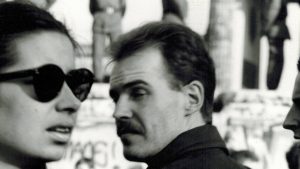Visualizations are widely understood to facilitate communication between academic historians and an interested public. They seem to hold great potential to open up urban historiography towards the ideals of “Citizens Science”. With this session we want to initiate a critical discussion on visualizations as a mean to engage actors beyond academia.
CfP: Tagung „Visuelle Repräsentationen des Parlamentarismus seit 1789. Ein europäisches Panorama“
Quelle: https://visual-history.de/2024/11/28/cfp-tagung-visuelle-repraesentationen-des-parlamentarismus/
CfP: Centers and Peripheries. Photography’s Geography Lessons
Quelle: https://visual-history.de/2024/10/18/cfp-centers-and-peripheries-photographys-geography-lessons/
CfP: Visualizations of War Captivity
Quelle: https://visual-history.de/2024/04/17/cfp-visualizations-of-war-captivity/
CfP: Mapping German Film Exile. A Transnational Perspective
Quelle: https://visual-history.de/2024/01/24/cfp-mapping-german-film-exile/
CfA: Jüdische Filmgeschichte(n) transnational: Europäische Perspektiven
Screenshot der Website: Jüdische Filmgeschichte, Filmuniversität Babelsberg Konrad Wolf
(Post-)Doktorand:innen Kolloquium
Jüdische Filmgeschichte(n) transnational: Europäische Perspektiven
Datum: Donnerstag, 04.03.2024
Ort: online
*English below*
Filmproduktion und Filmkultur haben seit ihren Anfängen nicht nur durch den Vertrieb und Verleih von Filmkopien und Technologien, sondern auch durch die Vernetzung von Personen transnationale Netzwerke geschaffen. Ebenso war das frühe Schreiben über Film und die angehende Filmtheoriebildung von der Pluralität der Stimmen aus den verschiedenen Bereichen und europäischen Kontexten geprägt. Transnationale Ansätze in der Forschungsliteratur haben Analysebeispiele zutage gebracht, wie die Untersuchung verschiedener (Sprach-)Versionen von Filmen und der personellen Vernetzungen im
internationalen Starsystem, die neue Erkenntnisperspektiven auf Filmgeschichte und Filmgeschichtsschreibung ermöglichen.
In diesem Geflecht von Film und Kinokultur können jüdische Erfahrungen und europäische Migrationsgeschichten als spezifische Erfahrungen und eigene Diskursnetzwerke sichtbar gemacht werden.
[...]
Quelle: https://visual-history.de/2023/12/19/cfa-juedische-filmgeschichte/
CfP: In the Thick of Images: Law, History and the Visual
Screenshot: University of Lucerne [01.12.2023]
The ‘visual turn’ has long been turning in critical and cultural studies of law (see Douzinas & Nead 1999). In the past twenty-five years, a growing body of scholarship has evolved that emphasises law’s “constitutive imbrication” (Crawley 2020) with an array of visual forms, and elaborates on the ways in which images “shape and transform legal life” (Sarat et al. 2005).
Weaving together an eclectic set of theories, concepts, methods and materials, such studies refuse thin readings of images as merely illustrative of law, and invite us to think more deeply about their ideological and visual operations – about the meanings they carry and make available, about their material presence and affective effects, and about the cultural-political and cultural-legal work they perform across their multiple contexts of production, circulation and reception.
[...]
Quelle: https://visual-history.de/2023/12/01/cfp-in-the-thick-of-images-law-history-and-the-visual/
CfP: Visual Representations as a Path to Participatory Urban History?
EAUH 2024, Session S26 “Visual Representations as a Path to Participatory Urban History?”
Session organizers: Kathrin Meißner, Sebastian Haumann
Screenshot der Website: EAUH 2024 Cities at the Boundaries
Visualizations have become an integral part of urban historiography because they are seen as a means to reach out to a broader public. This includes the reproduction of historical photographs or plans but also mapping techniques and increasingly interactive digital representations aimed at engaging diverse actors beyond academia. However, the potential of visualizations to serve as a catalyst for communicating urban history across different audiences has not yet been discussed systematically.
[...]
Historicizing Personal Identification and its Implication for Pandemic Response
Secure and precise personal identification is essential for the continuation of socioeconomic activities during a pandemic. In Japan, the main region of focus for this research, this became even clearer between 2020 and 2021 when multiple cases of online fraud involving identity theft took place, including a series of document forgery to receive a financial relief package and taking online job tests for someone else. When the next pandemic and the next lockdown come in the future, our society needs to be better prepared to face this challenge of continuing life under severely restricted in-person communication.
While there are various means of identification in our society today, such as fingerprints, PINs and passwords, identification by means of a photo ID is one of the most commonly used methods. Even with the emergence of new technologies such as facial recognition, ID card with portrait photographs still play an important role as they have already achieved a wide social acceptance and they are relatively cheap to produce or obtain. This trend is unlikely to change when a next pandemic compels us to replace face to face contacts with online interactions. Learning how portrait photographs have functioned in the context of personal identification, therefore, has policy relevance in our contemporary world in addition to being an intriguing subject of study in the field of visual history.
In order to gain historical insight into this issue, this study conducts a historical analysis of the policy debates and public discourses over the spread of personal identification technologies through a case study of ID photographs in 20th century Japan (see photograph 1).
[...]
Forced Labour 1940
Over recent years, several private photos of the persecution of the Hungarian Jews have been made accessible to the public online. However, due to the lack of historical context and basic metadata, these photographs remain difficult to trace.[1] This problem is particularly significant for international researchers without knowledge of Hungarian.
In 2020, I started examining ways to design and develop online exhibitions, and this short essay outlines the process and results: the online gallery “Forced Labour, Hungary 1940”. The aim of this project was to present and contextualise one small collection of family materials – two photo albums and a diary – to make them accessible for a broader, international public.
Photographer: Ervin Szántó. A group of forced labourers wearing tricolour armbands with family members.
[...]
Quelle: https://visual-history.de/2023/07/10/jones-forced-labour-1940/









